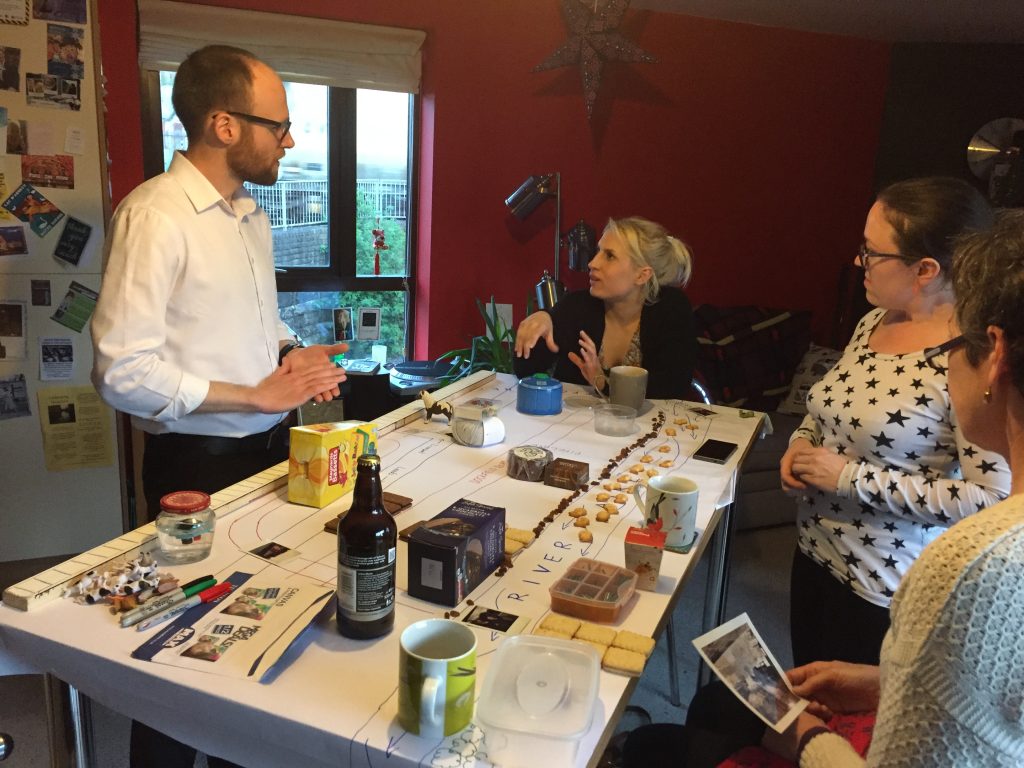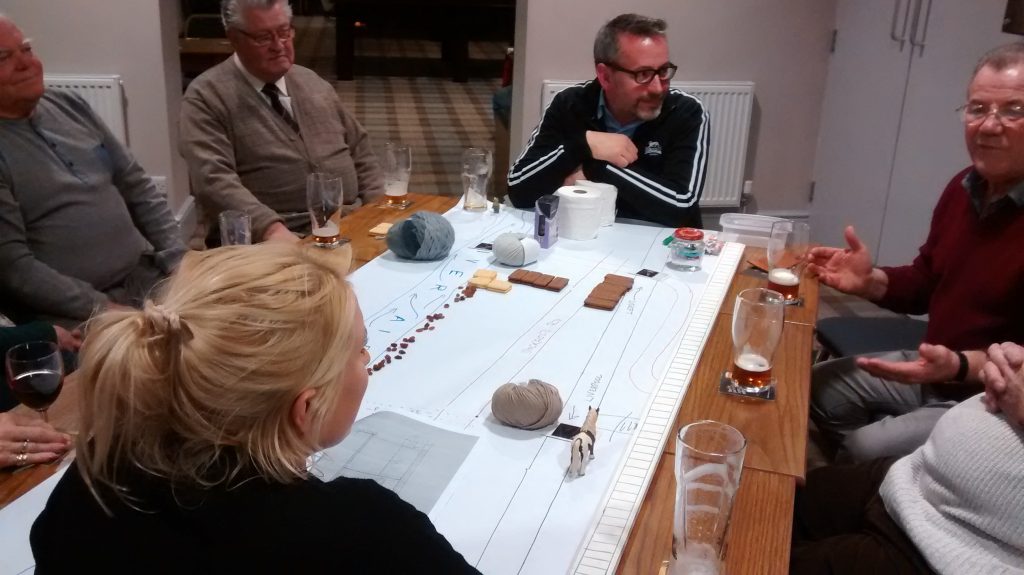This was the scene just last night, in one of the flats at Amber Wharf. That’s the new-build properties next to the canal, in the Dockfield area of Shipley.
Sitting at the end of the table is Kat Martin, my co-performer in This Island’s Mine, the two-person play that we’ve devised and written about the history of Dockfield, and the close relationship that industry and residents have always had here with the River Aire, the Bradford Beck, and the Leeds-Liverpool Canal. This was the latest in a series of performances we’ve been giving in homes and pubs/clubs over the last week or so.
The other folk in the picture are last night’s audience (who prefer not to be identified by name, but were happy for me to share this pic), and strewn across their kitchen table is the “stage” of our drama — a map of Dockfield built up during the course of the play, using ordinary household objects from Kat’s shopping bags. Meanwhile, this was the view out of the window…
This particular flat overlooks what was once the junction of the Leeds-Liverpool and Bradford Canals. That’s Junction Bridge, built in 1774 at the same time as these sections of the canal network, to allow horses to get across from one tow-path to the other. This junction features prominently in our story, during the play, and it’s been one of the fun things, in performing it, to be able to point directly to where we are “on the map” as we speak. We’re talking about places and things that our audiences know well, but bringing a different perspective to them. So far, the reactions have been great!
One of the key locations on our map is Saltaire Brewery, whose main buildings were built as an electricity works for Shipley Council at the beginning of the 20th Century (later nationalised under Yorkshire Electricity Board). We were privileged last week to present a public performance of the play in the beer yard outside the Brewery Tap — on a gorgeous April evening in the setting sun (which kept everyone just warm enough!).
The picture above was snapped early in the performance (at a historical moment when the fields of Dockfield-to-be are farmers’ fields, yet to be built on… hence the animals) by Janet Wojtkow, one of our spectators… Janet is the partner of Tony Gartland, the Brewery’s founder and owner, so she took particular pride in snapping this picture…
… at the moment when we talk about how the former electricity works (represented by the light bulbs) is now the Brewery (represented by the bottle of Blonde). I actually had to pause mid-performance for a moment while Janet took the picture — much to everyone’s amusement. But that’s one of the nice things about the informal, round-the-table set-up for this play… there is a script we’re following, but people can also interrupt, ask questions, make observations, and we try to improvise satisfactory responses. It gives the show a lovely sense of liveness and one-off-ness every time we do it.
This conversational approach is also designed to elicit further contributions from the audience after we complete our story. The talking continues… At the Brewery, for instance, Janet shared the full story of why Saltaire Brewery is not in fact located in Saltaire but in Dockfield (it would have been in Salts Mill, it seems, but for the untimely death of its owner Jonathan Silver – and the subsequent hesitations of the interim manager). And this was just one of the additional tales we’ve been told… Take Geoff Roberts, for instance, pictured here in blue just behind my head on the right of the picture…
Geoff worked for decades in water quality control — for Yorkshire Water and its predecessors — and following our tales of Dockfield’s sewage works and plumbing, he told us how his very first work assignment, as a new employee in 1973, was to visit the pumping station next to the footbridge at the bottom of Dock Lane (again – very much part of our map!) in order to remedy a fault. It was quite the trip down memory lane. This performance at Shipley’s Kirkgate Centre was also attended by some with even longer memories, who told tales of Shipley and Bradford in childhoods before World War II.
Our most responsive and vocal audience so far was at Baildon Woodbottom Working Men’s Club last week, where our audience was almost entirely made up of people who grew up in Dockfield itself, in the 1940s, 50s and 60s. Since the characters that Kat and I play — Barbara and Danny — are amalgams based on interviews with a number of folk of this sort of age (and also a bit younger… we’re deliberately vague about exactly how old the characters are), the performance sparked especially vivid memories from those watching. In the picture below, on the right, Tony Brannon is offering an observation, mid-performance…
… and you can tell its mid performance because the objects on the table are different from those we end up with at the end (see below!). Truth to tell, Tony had been one of my interview sources, and he’s also a regular at the club, so for him the performance really was like an extension of our previous conversations. He and the others became as much a part of the show as we were — in fact our 30 minute running time stretched to more like an hour, with all the interjections, observations, and debates prompted by our script! Personally, I loved the way that the line between ‘play’ and ‘audience’ became almost indistinguishable…
… and for all that they corrected — or at least disputed — some of our “facts” (as Tony said, everyone remembers things differently anyway), this audience was also especially appreciative of what we’d made. Mary (in the foreground on the left in the picture above) was especially keen, after the play, to know why we’d chosen to focus on Dockfield. She seemed delighted by the thought that the place she grew up in — the landscape of her own childhood, if you like — was being celebrated and remembered in a play (however low-key and informal it might be as a play). I had the sense that her own sense of pride in the specialness of that place was somehow being confirmed by this outside intervention. And she had a few additional stories to tell of her own — like the way that the railings along Dockfield Terrace had been cut down during the war, to feed the urgent need for metal for the war effort…
What I’m really proud about with this play, so far, is that it seems to “work” in different ways for different audiences. For these people at Woodbottom Club, it provided an opportunity to look back and remember together — they carried on talking for hours (literally) after the performance, but were still thanking us for this “special evening” when they left. Conversely, our hosts last night at Amber Wharf are relatively new arrivals in Dockfield, and so the play helped to ground them in the history of the place and answer some of the questions they had about it. In the end, I suppose, that’s the great thing about storytelling… a story has a shape of its own, but it can mean different things to every spectator, depending on the interests and experiences they bring to it.
++++
Postscript. This was tonight’s performance — Wednesday April 19th — at Saltaire Brewery Tap. This week we came inside (no setting sun to warm us this time), and were joined by the biggest and most diverse audience we’ve had yet… Diverse in terms of both age and background. Gathered in two rows around our table, they included long-term Dockfield residents, more recent arrivals, and visitors from right out of town!
Indeed, among those present were a family from the Midlands… theatre and cinema enthusiasts who had come up to see the “magic lantern” collection at the Bradford Media Museum (an old-fashioned form of colour slide projection), only to discover that the collection has been shunted off down to London. They seemed delighted by our show, though (as if reassured that the North had managed to keep some culture of its own!). Despite knowing nothing about the Shipley area, they said that the history of industrialisation — that we tell through the microcosm of Dockfield’s story — was one they very much recognised from their own Black Country background.
“You’ve invented a new paradigm”, one of them told me afterwards. I confessed to not knowing what he meant. “A new model for doing plays,” he explained. “You could take this format and tell the story of anywhere.” And I suppose you could… Personally, I wouldn’t claim to any enormous originality in the format of this piece: the component parts come from a range of theatre forms. But it’s true I haven’t seen them combined in quite this way before, or for quite this purpose (telling the up-close story of a place, through the use of characters, rather than the story of characters, that’s set in a place). As I say, though, what’s most special to me about this piece is the way that it seems to invite such spontaneous, conversational responses — even as we’re performing it.
Acknowledgements: Special thanks are due to Kat Martin, my wonderful co-performer in this piece, and to Simon Brewis – our director, who also guided us skilfully through the play’s development phase, from my initial draft script. Simon also took the pics of the Woodbottom performance. Thanks also Janet Wojtkow (whose pics I pinched off our Facebook feed, where she’d uploaded them), Paul Barrett (for the Kirkgate Centre pic), and Ruth Bartlett (for tonight’s Brewery pics).










